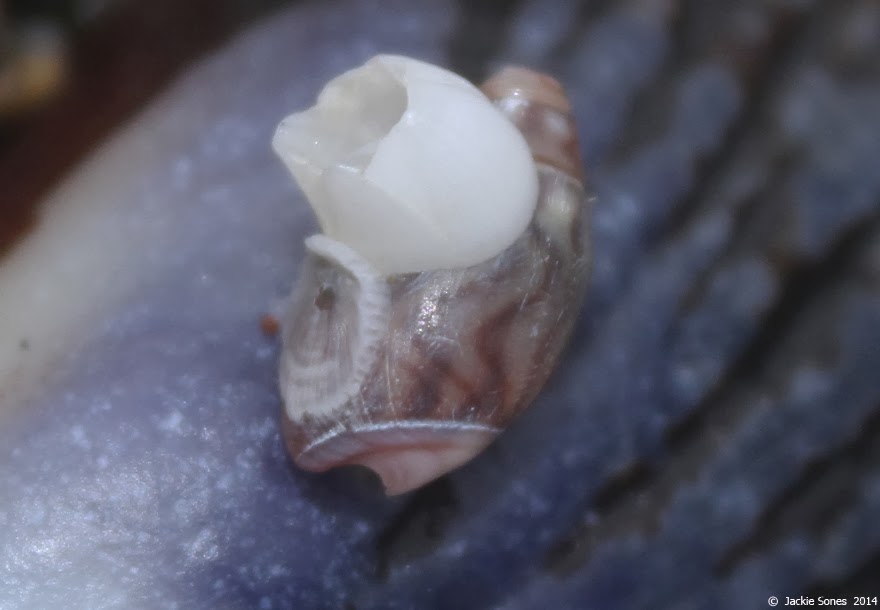The Purple Olive is on the left, Zigzag Olive is on the right. Along with the difference in coloring and shell pattern, compare their overall shapes (imagine if you were to draw an outline of each) and especially their spires (the whorls at the tops of their shells).
Olive shells are generally very smooth (they're often described as "lustrous"). But as I was picking up various Zigzag Olive Shells for the picture I encountered one with a rough patch (see below) that caught my attention.
Do you have a guess about what the rough patch is? I thought I knew, so I kept on looking at other shells with the hope that I could confirm my suspicion. Warning: I'll reveal the answer in the next photo.
I was fortunate to find a second snail with a barnacle shell still attached! The rough patch on the first shell is the basal plate of a barnacle.
The picture below shows the same snail from a slightly different angle so that you can see both the barnacle shell with its wall plates still intact and a second barnacle with only the basal plate remaining.
I've seen quite a few olive snails, but I think this is the first time I've noticed barnacles growing on them. Has anyone else observed this? Eric's first thought was that it makes sense given that olive snails live in sandy environments and that barnacles are looking for hard substrates to grow on. The snail shell offers the barnacle a resource that may be in short supply.
I was surprised at the size of the barnacles relative to the size of the snail — they seemed quite large! It made me wonder if the barnacle would have any impacts on the snail. Would it change the water flow? Would it affect maneuverability? Because olive snails are sand burrowers, would the barnacle attract undue attention (from predators) by increasing height and extending above the surface of the sand? Would there be any benefits to having a barnacle on your back?




5 comments:
I've had a barnacle on my back for years and haven't noticed a single benefit.
I found one washed up at Strawberry Hill several years ago that had several barnacles that size. It didn't seem surprising at the time, since everything at SH ends up covered with barnacles...
I can't confirm if they were there while it was still alive, but it's seems even harder to imagine that they would grow on a loose shell.
I kept it for a while, and it might be buried somewhere in my collection still.
-Matt
Interesting, Matt! I'm assuming your observation was on a Purple Olive at Strawberry Hill? Fun to think through what would increase the likelihood of barnacles being able to grow on olive shells. Their shells are so smooth I had started to wonder if it would require some sort of nick in the shell where a barnacle cyprid could settle?
Do you know if the snails in purple olives switch shells or the grow as they age?
Hello!
Olive Snails can't leave their shells, so both the snail and its shell will grow larger together.
I hope this helps!
Jackie
Post a Comment